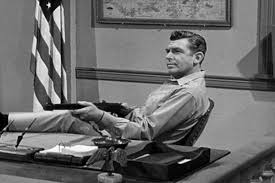
Why Andy Griffith Believed in Peace Even With a Gun in Hand
The image is indelible: Sheriff Andy Taylor, perched on the edge of his desk in the Mayberry Sheriff's Office, perhaps whittling, or gently strumming his guitar, a faint smile playing on his lips. On his hip, often visible, is a holstered revolver. Yet, for all the episodes of "The Andy Griffith Show," that gun remained largely a silent, even inert, prop. It was a tool of his office, a symbol of authority, but never, it seemed, a weapon of first—or even last—resort. Andy Griffith, through his iconic portrayal of the small-town lawman, embodied a unique philosophy of peace: one that acknowledged the necessity of force, but consistently chose understanding, persuasion, and empathy over its application.
The very presence of the gun highlights the paradox. A lawman's primary duty is to uphold order, which inherently involves the potential for conflict and the use of force. But Andy Taylor turned this on its head. His "gun in hand" was not a threat, but a promise – a promise of the quiet, underlying power that meant he didn't need to brandish it. It was a badge of his benign authority, a visual cue that ensured a certain respect, but never inspired fear. Unlike his eager-beaver deputy, Barney Fife, who viewed his single bullet and pearl-handled revolver as extensions of his own insecure ego, Andy’s gun was simply part of the uniform, worn almost as an afterthought. It was often left in a desk drawer, or, famously, used to keep a fishing line from tangling. This casual disregard for its immediate purpose underscored his deeper belief: the true power of a lawman lay not in his weapon, but in his wisdom.
Andy’s approach to maintaining peace in Mayberry was rooted in a profound understanding of human nature. He rarely saw criminals; he saw troubled souls, misguided individuals, or simply people making mistakes. When Otis Campbell, the town drunk, would peaceably lock himself in a jail cell for the night, Andy didn't need to draw a weapon or even raise his voice. He understood Otis’s predictable pattern, his inherent harmlessness, and his need for a safe space to sleep it off. The "threat" was managed through compassionate familiarity, not force. Similarly, when eccentric Ernest T. Bass would pelt the courthouse with rocks, Andy’s solution wasn't to subdue him with brute force, but to engage him on his own terms, often with a clever trick or an appeal to his peculiar sense of honor. The gun remained holstered because Andy's primary weapon was his mind, his ability to de-escalate, to talk people down, to find the common ground or the hidden motive.
This quiet, disarming approach fostered a unique kind of community peace. Andy didn't just enforce laws; he nurtured relationships. He was a father figure to Opie, a patient mentor to Barney, a respectful neighbor to everyone. His actions demonstrated that true order comes not from iron-fisted rule, but from a shared understanding of right and wrong, and a communal commitment to living harmoniously. The jail, under his watch, was less a place of punishment and more a temporary time-out, a place for reflection, or even a safe haven. It was a testament to his belief that most people, given the right guidance and a little understanding, would choose peace over conflict, cooperation over defiance.
In essence, Andy Griffith, through Andy Taylor, illustrated that the presence of a gun does not inherently preclude a belief in peace. Rather, it can highlight the strength of that belief. For Andy, the gun represented the quiet, underlying authority that allowed him the freedom to choose a better path. It was a reminder that power, when held by a truly peaceful and wise individual, can be used not to dominate, but to uplift; not to destroy, but to restore; not to coerce, but to inspire. His peace was not a naive absence of conflict, but an active, deliberate choice to meet potential aggression with intelligence, empathy, and an unwavering faith in the fundamental goodness of people—even with a gun, unseen but ever-present, by his side.
